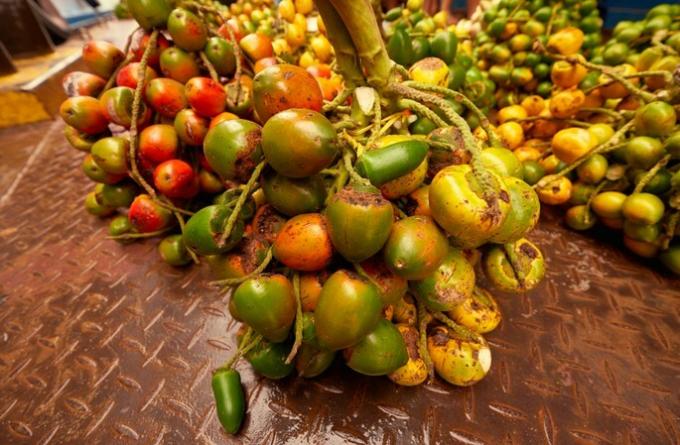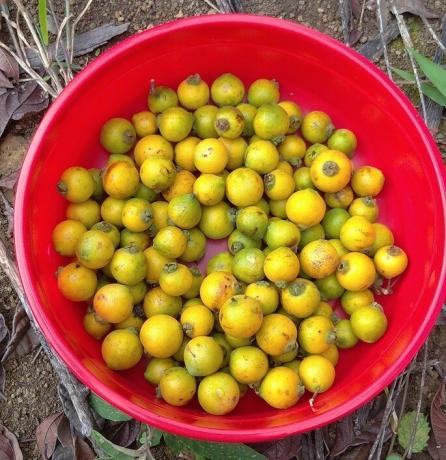Brazilian fruits are those that originated here, in Brazil. Of the most common fruits in the diet of Brazilians, not all are native from Brazil, such as apples, bananas, mangoes, papayas, watermelons, oranges and lemons.
Fruit is the popular term for a fruit, usually sweet and edible. While fruit is the botanical term used to name a fertilized ovary that contains seeds.
For a fruit to be native it is necessary that, firstly, an organism of the Vegetal Kingdom arise, through evolution, in a certain region. It would be the same as saying that anyone born in Brazil is Brazilian, even if they later migrate to another country.
Typical fruits of Brazil
From a survey with a group of botanists to rescue and better understand the Brazilian flora, almost 50,000 native species were identified.
Among them are the plants that produce originally Brazilian fruits. most of typical fruits from Brazil, that is, native to the Brazilian territory, are little known by the general population, therefore, little consumed.
However, there are Brazilian fruits that are commercially exploited, such as pitanga, O pineapple and the cashew.
1. Tootles

the species Mucous Annona is popularly called Tootles,araticum, soursop or countess fruit. It belongs to the Annonaceae botanical family and is native to the North and Northeast regions.
Biribá is commonly sold on a small scale, at fairs in the interior of the states in the North and Northeast regions.
Biriba has about 13.5% carbohydrates, 12% fibers, 0.7% lipids and 0.5% proteins. It is usually consumed fresh, but it is often used in the preparation of juices, wines, ice cream or jellies.
The leaves, fruit pulp and seeds are used in folk medicine to combat colic, diarrhea, vomiting and general malaise.
2. Jenipapo

The fruit in question is of the species Genipa americana which belongs to the botanical family Rubiaceae. It occurs only in Brazil, being found in all Brazilian regions.
popularly known for cabaçu, janipaba, jenipapo-branco, jenipapo or jenipava. The fruit is consumed mainly as jams, jellies, liqueurs or wines, genipap is rarely consumed fresh (in natura).
It has high nutritional value, with about 5.2g of protein, 9.4g of fiber and 3.6g of iron per 100g of fruit. Due to the presence of iron, in the Northeast, it is used to combat anemia, as juice and/or pulp mashed with sugar.
3. Tucumã

popularly known as tucumã-do-amazonas, tucumã-açu or tucumã-pitanga, This fruit belongs to the botanical family Arecaceae, of the species Astrocaryum aculeatum It is Astrocaryum vulgare Mart.
Native to the North and Midwest regions, it is an important food source for the populations of Amazonas and Pará. are consumed in natura, in juices, ice cream, jellies, sweets and even sandwich fillings.
It contains high levels of lipids (unsaturated fat), in addition to being rich in vitamins A, B, fiber and beta carotene.
4. Uxi

This Brazilian fruit belongs to the Humiriaceae botanical family and its scientific name is endopleura uchi. It is native and endemic to the Brazilian Amazon and spreads to other states in the North region.
It is the plant that produces the fruit popularly known as axuá, cumaté, paruru It is uxi-true.
Commonly ingested fresh, in addition to being used in the preparation of ice cream, soft drinks, sweet paste, pudding and liqueur. In rural regions, it is consumed with cassava flour, and its seeds are used in handicrafts.
5. Guabiroba

Guabiroba is a Brazilian fruit originating in the South region, but it occurs in the States of Minas Gerais and São Paulo. popularly known as guaviroba, guabiroba It is guabirova.
It belongs to the botanical family Myrtaceae and the scientific name is Campomanesia xanthocarpa. The fruit is tasty, juicy and slightly acidic, commonly consumed fresh, in addition to being used in the preparation of ice cream, sweets, liqueurs and juices.
The fruit pulp contains proteins (0.4%), calcium (0.009%), potassium (0.1%) and other mineral salts in lower concentrations.
6. physalis

It is also known as capucho tomato, little balloon, camapum It is hoodie, belongs to the Solanaceae botanical family and its scientific name is Physalis pubescens.
This fruit of Amazonian origin has a wide distribution in all regions of Brazil, Argentina and North America. It is widely used in French, Swiss and Colombian cuisine, where it is served as an accompaniment to tea or covered in chocolate.
Physalis is rich in proteins (10.35%), in addition to mineral salts such as magnesium (0.16%), phosphorus (0.34%) and potassium (2.3%).
7. Feijoa

Feijoa is a fruit very similar to guava., For this reason, it is popularly known as mountain guava,mountain guava or bush guava. It belongs to the botanical family Myrtaceae and its scientific name is Feijoa sellowiana.
This native Brazilian fruit occurs at altitudes greater than 900 meters in some states in the southern region and is widely consumed by the local population. in natura.
8. sleeve

Also known as cerrado mangaba It is northern mangaba, this fruit belongs to the Apocynaceae botanical family and its scientific name is Hancornia speciosa. It has a wide distribution in Brazil, being found mainly in the Cerrado biome.
Because it has a pleasant flavor, this Brazilian fruit is consumed fresh, but it is common to prepare juices, sweets, ice cream or popsicles.
It is considered a great source of iron, zinc, manganese and vitamin C, in addition to being low in calories, as each 100g of pulp has 48 calories.
9. Araçá-boi

The araçá-boi originates from the Amazon region, it is also known as ahaha or arrack. It belongs to the botanical family Myrtaceae and the species Eugenia stipitata.
The pulp of the fruit is very nutritious and interesting for human consumption. 10g of pulp contains the daily amount of vitamin A for an adult.
10. umbu

The umbu is a fruit of the botanical family Anacardiaceae and of the species tuberous spondias. It has a strong evolutionary relationship with the cajá and is also called imbu, imbu or ambu.
The species occurs in the Northeast and Southeast regions, with main occurrence in the Brazilian semi-arid region. The fruit is consumed in natura, such as candy, juices, ice cream and popsicles.
11. Jabuticaba

The fruit of the species Plinia peruviana belongs to the Myrtaceae botanical family and is well known by Brazilians. Usually they are consumed fresh or are used in wines, juices, syrups, sweets or vinegars.
Jabuticaba, also popularly called jabuticaba-sabará or jabuticaba-mineira,has a wide distribution in Brazil, occurring in almost all regions of the country.
Other fruits native to Brazil
| fruits | Scientific name | Biome |
| 12. pequi | caryocar brasiliense | thick |
| 13. cashew | mombin spondias | thick |
| 14. Açaí | Euterpe oleracea / E. edulis | Amazon Forest / Atlantic Forest |
| 15. peach palm | Bactris gasipaes | Amazon rainforest |
| 16. cupuaçu | Theobroma grandiflorum | Amazon rainforest |
| 17. plantain | bromeliad antiacantha | Atlantic Forest and Pampa |
| 18. Abiu | pouteria caimito | F. Amazonica, M. Atlantic and Cerrado |
19. Bacuri |
platonis insignis | thick |
| 20. Cocoa-alligator | herrania mariae | Amazon rainforest |
Know more:
- 50 most consumed fruits and their benefits
- 10 exotic fruits found in Brazil
Bibliographic references
CARVALHO, J. AND. U.; MÜLLER, C. H. Biometrics and percentage yield of pulp from native Amazonian fruits. Technical notice 139, P. 1–3, 2005.
CORADIN, L. et al. Native species of Brazilian flora with current or potential economic value: plants for the future: South region. Brasília, DF: Ministry of the Environment, 2011.
CORADIN, L.; CAMILLO, J.; PAREYN, F. G. W. Native species of Brazilian flora with current or potential economic value: plant for the future: Northeast region. Brasília, DF: Ministry of the Environment, 2018.
CORADIN, L.; SIMINSKI, A.; REIS, A. Native species of Brazilian flora with current or potential economic value: plants for the future: North region. Brasília, DF: Ministry of the Environment, 2022.
VIEIRA, R. F.; CAMILLO, J.; CORADIN, L. Native species of Brazilian flora with current or potential economic value: plants for the future: Midwest region. Brasília, DF: Ministry of the Environment, 2016.
CASTILHO, Rubens. Brazilian fruits: discover 20 varieties and their regions.All Matter, [n.d.]. Available in: https://www.todamateria.com.br/frutas-brasileiras/. Access at:
See too
- fruits
- exotic fruits
- Animals of the Atlantic Forest
- Flora of the Caatinga
- 50 super difficult words and their meanings
- Cerrado animals
- Animals of the Caatinga
- Extractivism in Brazil

